Macro Quarterly Navigating the storm
The spread of the coronavirus outside of China, oil price collapse and sharp tightening of financial conditions have put the global economy on the brink of recession.
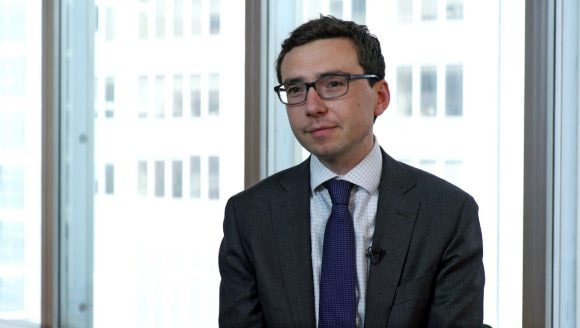
Highlights
Highlights
- The COVID-19 spread, oil price collapse and broader illiquidity in fixed income and particularly credit markets has created a perfect storm for markets and the economy.
- As major economies essentially shut down for unknown durations to control the spread of COVID-19, pinpoint economic forecasts are unrealistic. Investors must think in terms of scenario-based outcomes as opposed to normal distributions.
- As part of this, investors should respect the potential for aggressive monetary, liquidity, regulatory and fiscal policy responses which can trigger sharp changes in the market narrative.
- These dynamics create extreme market volatility making market timing very difficult and prudent risk management essential. We prefer relative value to large market directional bets in the near term.
- Longer term investors should not lose sight of the big picture. Overall economic imbalances are much healthier than prior to the Great Financial Crisis of 2008/09.
- Expected returns for risk assets over the intermediate to longer term have increased as risk premiums have widened, reflecting near-term uncertainty.
The perfect storm
The perfect storm
The spread of the coronavirus outside of China, oil price collapse and sharp tightening of financial conditions have put the global economy on the brink of recession. Whether or not the hit to the economy ends up meeting a formal definition of a recession, for markets it has felt like one. The 21% fall in equities over the 16 days through last Thursday rivals some of the biggest market crashes in history and the four-day widening of credit spreads from Monday through Thursday last week was even sharper than during the height of the Great Financial Crisis. All in, the S&P 500 had a max drawdown of 27% from its all-time high set on the 19th of February through Thursday, before a dramatic counter-trend surge in the final minutes of Friday's trading session erased much of Thursday's losses. Over recent months, Treasuries have held up their defensive properties (something we highlighted in our piece US Treasuries: Overvalued but Valuable) but were volatile in recent days given distress in the overall market.To state the obvious, overall cross-asset volatility is exceptionally high.
In addition to the humanitarian crisis that COVID-19 has caused, the necessary actions to slow down its spread inevitably trigger a sharp contraction in activity, with perhaps longer lasting hits to sentiment. Modern economies and markets haven't quite seen anything like this before, making it exceptionally difficult to determine the impact on economic and corporate fundamentals with confidence. Indeed, major economies are essentially coming to a sudden stop, the duration of which is unknown. Shutdowns for several weeks is one thing, but the longer this goes on, the greater the potential for a non-linear deterioration for households and businesses. As such, we are not operating in a normal distribution and we must think in terms of scenario-based outcomes with wide confidence intervals.
Exhibit 1: History of US equity market crashes
Exhibit 1: History of US equity market crashes
Event | Event | Date | Date | 16-day change (%) | 16-day change (%) |
|---|---|---|---|---|---|
Event | Wall Street Crash of 1929 | Date | 10/29/1929 | 16-day change (%) | -33.6 |
Event | Black Monday | Date | 10/19/1987 | 16-day change (%) | -31.3 |
Event | End of Gold Standard | Date | 10/5/1931 | 16-day change (%) | -26.7 |
Event | Lehman crisis | Date | 11/20/2008 | 16-day change (%) | -25.2 |
Event | World War 2 | Date | 5/21/1940 | 16-day change (%) | -24.6 |
Event | COVID-19 outbreak | Date | 3/12/2020 | 16-day change (%) | -20.7 |
Event | DotCom bubble | Date | 7/23/2002 | 16-day change (%) | -19.3 |
Event | Post-WW2 demand shock | Date | 9/10/1946 | 16-day change (%) | -16.9 |
Event | US debt downgrade | Date | 8/8/2011 | 16-day change (%) | -16.7 |
Event | Great Financial Crisis | Date | 3/4/2009 | 16-day change (%) | -13.8 |
Event | LTCM | Date | 8/5/1998 | 16-day change (%) | -8.7 |
Aggravating the broader market impact has been a significant loss of liquidity in key areas of fixed income, notably in funding, Treasury and corporate debt markets. This is caused in part by financial intermediary retrenchment, post-crisis legislation leading to bank hoarding of reserves and limited corporate bond inventory held by dealers. As such, selling equity or credit ETFs has proven a liquid means for investors to de-risk when they have difficulty doing so in less liquid underlying markets. Note the significant discounts to Net Asset Value in some corporate bond ETFs illustrating the liquidity mismatch. Another concern is the perception that monetary policymakers have run out of ammunition to provide needed accommodation and stability in financial markets. With policy rates already near the effective lower bound across developed economies, fiscal policy must step in. Of course, this by definition involves the political process and is slower than monetary policy to decide upon and implement.
Respect the policy response
Respect the policy response
With all of the above commentary about what has gone wrong, it is important to emphasize risk assets have already adjusted sharply to the downside, reflecting many of the concerns noted. Equally important is that with market volatility so high, even the introduction of small policy moves can lead to powerful and dramatic reversals such as the one which coincided with President Trump's press conference late Friday afternoon. The policy measures announced were modest, but even just the hint of a game plan (following Wednesday evening's disappointing press conference) coincided with a stunning reversal in markets. Bottom line: given broad policy skepticism the markets can rally aggressively in response to even the hint of policy leadership.
And we would warn against counting out a mobilized monetary and fiscal response that in coordination could be quite powerful in arresting the downside. Central bankers still have the capability to provide a bridge until meaningful fiscal stimulus arrives. In addition to cutting rates to zero and expanding quantitative easing this past week, the Fed will not hesitate to reopen the variety of programs it unveiled during the financial crisis to improve funding conditions. The most powerful step the Fed can take (upon authorization of the U.S. Treasury Department) is to open up a version of the Term Asset-Backed Lending Facility (TALF). In 2009, this program provided non-recourse lending to entities pledging consumer ABS collateral. Conceivably in this new funding program, corporate debt could be pledged as collateral without mark to market or re-margining requirements. This would provide significant funding relief to banks and other owners of distressed corporate assets.
Exhibit 2: Credit ETFs trading at a meaningful discount to NAV
Exhibit 2: Credit ETFs trading at a meaningful discount to NAV
Major credit ETF premium/Discount to NAV (percentage points, 1M exponential moving average)
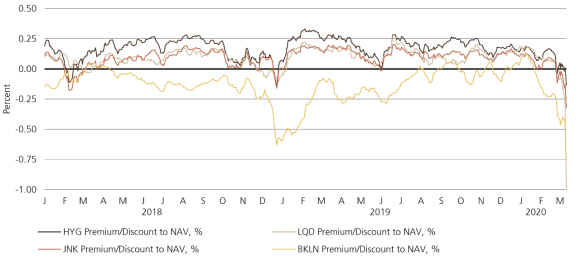
Elsewhere in the world, ECB President Lagarde had to walk back comments last week suggesting that it wasn't the ECB's job to narrow European government bond spreads. Since then, she and the ECB have gotten back on message and importantly stepped up purchases of Italian BTPs. Moreover, the ECB Governing Council offered significant regulatory relief to banks and increased the attractiveness for them to lend. The People's Bank of China continues to reduce reserve requirements on its banking system, ease regulatory constraints and maintain accommodative monetary policy. The UK and Canada have announced coordinated monetary and fiscal steps which give a signal of what is to come in other developed economies.
Indeed, there are signs that fiscal policy is gaining traction. China has been early to this, significantly stepping up infrastructure investment which can now properly get going as the country gets back to full capacity after the initial coronavirus shock. Germany, which has long been hesitant to engage in meaningful spending, has had made a clear pivot towards stimulus. This sets the tone for the rest of Europe, including loosening budget constraints across the region. The US response has been as divided and partisan as ever, but there are at least tentative signs of bipartisanship with Treasury Secretary Mnuchin and Democratic Speaker of the House Nancy Pelosi at the time of writing close to a deal on some incremental health and fiscal support. Much like the several TARP votes of 2008, market and economic stress may need to be the trigger to focus minds for a much larger fiscal package. One is still likely over coming weeks given the elevated stakes for all officials, though perhaps with not as much speed as households, businesses and markets would like. In the end though, individual politicians do not want to be seen as failing the public against a major health and economic threat in an election year. Overall the monetary and fiscal cavalry is mobilizing and it can be dangerous for investors to aggressively bet against them.
The bigger picture
The bigger picture
We hear a number of references to the Great Financial Crisis in terms of the potential scale of drawdown in this period of financial market and economic stress. While some of the day to day price action is reminiscent of that period, it is important to keep perspective on underlying fundamentals. The depth of any recession is a function of the buildup in leverage prior to that recession and the need to retrench over a multi-quarter period. Households were significantly overleveraged and banks well under-capitalized heading into 2007-2008. The sharp de-leveraging of both meant a much deeper and lasting recession. But today households and banks are in much healthier shape. Now, there is little question that after the longest economic cycle in history there has been some excessive risk-taking, reduction in credit quality and rise in leverage in the corporate sector. But the overall scale of necessary deleveraging does not come close to that which was necessary in the last recession. Scale matters here in terms of the danger of private sector debt in the economy. Non-financial corporate debt to GDP levels are much lower than households, which on a macro level have precautionary savings to cushion the blow to incomes. Note too that ultimately extremely low oil prices and interest rates will provide a powerful tailwind for developed economy consumers when the health and economic stresses ease somewhat.
If there is any 'good' news in any market sell-off like the one we are undergoing, it is that expected returns on risk assets improve going forward. Simple versions of the equity risk premium have widened out to more attractive levels, and low bond yields are not going away anytime soon. This provides opportunities in some risk assets for longer-term investors who are willing to endure near-term market volatility. This needs to be done with the awareness that timing the market is very difficult and keeping some risk powder dry to take advantage of potential further price dislocation in the short term is sensible in capturing these long-term returns.
Exhibit 3: Corporate debt is a much smaller share of GDP than household debt to GDP
Exhibit 3: Corporate debt is a much smaller share of GDP than household debt to GDP
US Household and Corporate debt as a percentage of GDP
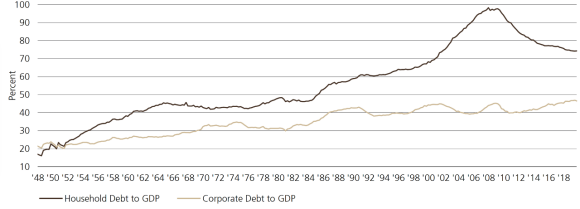
Exhibit 4: The attractiveness of equities relative to bonds has improved to highest levels since 2013
Exhibit 4: The attractiveness of equities relative to bonds has improved to highest levels since 2013
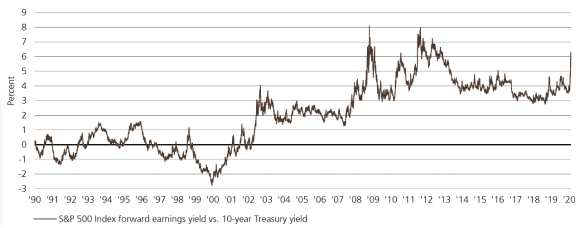
What we are doing
What we are doing
The still-accelerating number of coronavirus cases ex-China, shutting down of economic activity for unknown durations, financial market illiquidity, extreme market volatility and fluid policy responses mean we are managing overall beta risk carefully in the near term. As discussed earlier, economic outcomes are very uncertain and the combination of all the above factors will drive markets in unpredictable ways. Indeed, we see this environment as one more conducive to relative value trades than large outright bets on market directionality, for now. For example, we are overweight equities indices in China and Korea relative to developed economy equity markets. These Asian countries are closer to the end than the beginning of this health crisis and where we are seeing the largest fiscal response. In fixed income, we continue to see value in long US Treasuries relative to German bunds, given more potential for long-term rates to fall in the US than in Europe. In FX the cheap, safe haven JPY continues to provide useful diversification across our portfolios while we seek out differentiated relative value opportunities across the world. More broadly, periods of market dislocation always provide unique opportunities which we in Investment Solutions and our colleagues across UBS Asset Management are laser focused on identifying and exploiting.
Beyond investing, we wish our clients and their families good health and peace of mind during this uniquely disruptive time in our communities.
Asset class attractiveness
The chart below shows the views of our Asset Allocation team on overall asset class attractiveness, as well as the relative attractiveness within equities, fixed income and currencies, as of 11 March 2020.
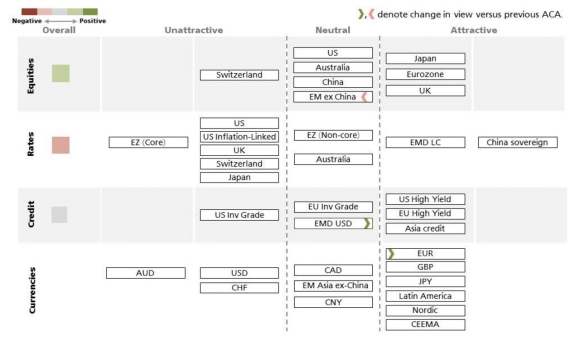
Make an inquiry
Fill in an inquiry form and leave your details – we’ll be back in touch.
Introducing our leadership team
Meet the members of the team responsible for UBS Asset Management’s strategic direction.
